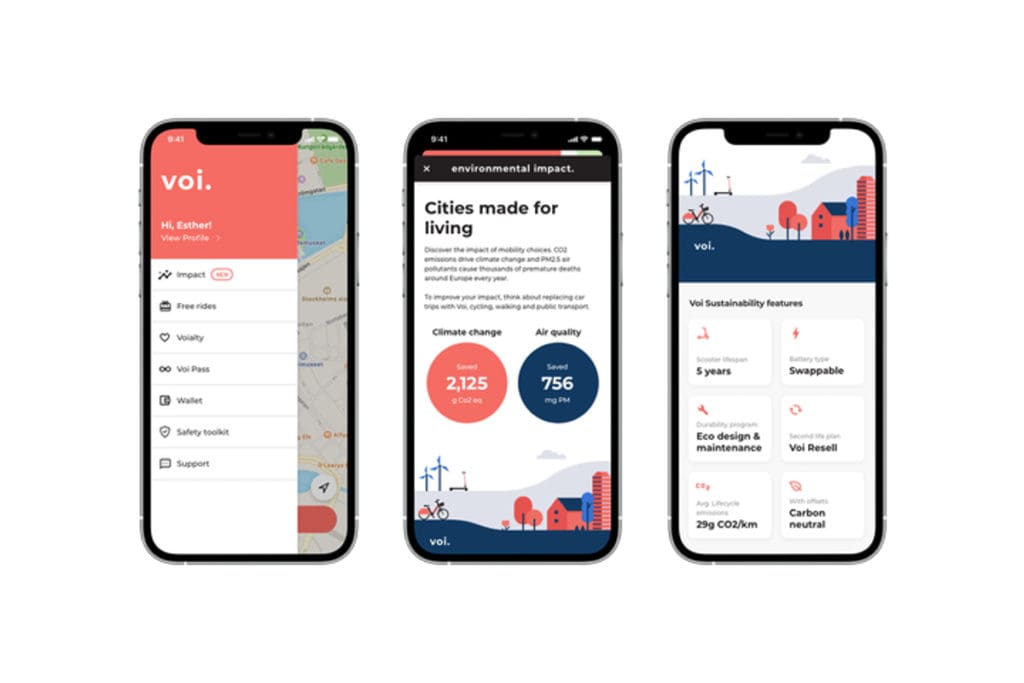Voi App Displays Carbon Impact

Stockholm, Sweden
Swedish scooter and bike share operator Voi has launched an ‘environmental impact dashboard’ to show riders the carbon emissions and air quality impacts of their journeys.
Voi launched the dashboard as part of its app, to coincide with the first day of the COP26 climate summit in Glasgow.
The dashboard shows Voi riders the estimated CO2 emissions and air pollution they have avoided by travelling by scooter or e-bike, compared to other forms of transport.
The emissions reading takes into account CO2 equivalents produced across the scooter or e-bike’s full life cycle, from construction right through to their recycling.
“The average Voi scooter ride emits 29 grams of CO2 equivalent per passenger per kilometre of life cycle emissions, compared with 184 grams per passenger per kilometre emitted by a passenger car,” according to a statement from Voi, quoting car emission figures from the International Council on Clean Transportation.
“Our current life cycle emissions have been significantly reduced over the past three years. This is mainly due to the fact we have succeeded in extending our e-scooter lifespan to five years, as part of our Durable Scooter Programme.”
The dashboard uses a carbon calculator developed in association with Dr Manos Chaniotakis, a lecturer in Transport Modelling and Machine Learning at the University College London.
On the eve of ‘Transport Day’, held on Wednesday as part of COP26, Voi called for greater international attention on micromobility as part of the solution for reduced transport emissions.
“The spotlight at international levels continues to be on the electrification of traditional vehicles, mainly cars. Active and shared modes of transport, such as walking, cycling or micromobility, are often neglected at climate conferences,” Voi said in a statement.
“We are advocating for an expansion of the sustainable transport narrative. Our main message is clear and simple; if we want to accelerate inclusive net-zero transport, electrifying cars will not be enough.
“We must systemically rethink our transport systems. Active and shared modes must be building blocks for sustainable transport systems.”
Goal to Replace a Billion Car Journeys
Voi has set itself a goal to replace over one billion car journeys by 2030. To date, Voi riders have replaced 11 million car rides and saved over 3,000 tonnes of carbon emissions since 2020.
According to data collected from Voi’s users throughout Europe in 2020-21, an average of 15.4% of users are leaving their cars at home in favour of a scooter ride. This figure was 39% in the UK.
Those figures represented a 15.3% increase in car replacement compared to the previous year.

“This indicates that as the service, infrastructure and regulations mature, the potential for car replacement and decarbonisation will grow,” the statement says.
It says improvements in scooter durability had enhanced their potential as sustainable transportation. While initial generations of e-scooters had a lifespan of around one year, because they were not well adapted to share use and intensive wear and tear, the current third generation Voi scooters would last an average of five years.
In addition, 90% of Voi’s Voiager 4 model is recyclable and the company is working towards having 95% recycled material used in vehicle production by 2025.
“We also have a zero-waste policy, reuse spare parts and give vehicles and batteries a second life as long as they meet safety requirements,” according to the statement.
Speaking at the COP26 summit, Voi CEO and co-founder Fredrik Hjelm announced the company was aiming to be carbon positive by 2030 – without carbon offsetting.
“We have already been carbon neutral across all our operations since January 2020,” he said, outlining several measures to be carbon negative in a decade:
Sourcing battery cells and scooters from within Europe, Voi’s e-bikes are already produced in Europe.
Moving to a fully electric vehicle fleet, including the vehicles used to transport Voi’s scooters and e-bikes
Working with Voi’s suppliers to ensure the whole supply chain is powered by renewable energy, with a view to creating a circular production model.
